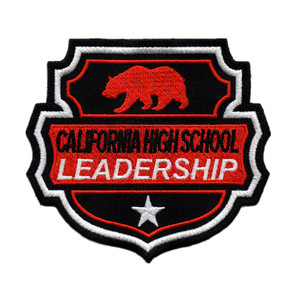
All categories
Featured selections
Trade Assurance
Buyer Central
Help Center
Get the app
Become a supplier

(177021 products available)













































Embroidery patches come in various types, each with unique characteristics and applications. Here are some of their main types:
Iron-On Embroidery Patches
They are popular for their ease of application. These patches feature a heat-activated adhesive backing, allowing them to be attached to fabric using an iron. This method is quick and convenient, making it suitable for home repairs or adding decorative elements to clothing. Iron-on patches are ideal for cotton, polyester, and similar materials. They do not adhere well to nylon or leather. They are widely used for patching up holes in clothes, personalizing jackets, jeans, and bags, and as temporary solutions until a more permanent attachment can be made.
Sew-On Embroidery Patches
These patches are favored for their durability and permanence. They require a needle and thread for attachment, which can be time-consuming but results in a secure and long-lasting bond. Sew-on patches are versatile and can be applied to various fabrics, including denim, canvas, and leather. They are often used by military organizations, sports teams, and businesses for branding and identification purposes. Additionally, they are great for repairing damaged clothing, as they create a robust and resilient bond with the fabric.
Self-Adhesive Embroidery Patches
They offer a simple and straightforward application process. These patches come with a sticky backing, allowing them to be pressed onto fabric without the need for sewing or ironing. They are best suited for light use and are ideal for temporary applications or for use on fabrics that cannot be ironed or sewn, such as nylon or leather. Self-adhesive patches are commonly used for craft projects, quick repairs, and as decorative elements on bags, hats, and home textiles. However, their bond may weaken over time or after washing, necessitating a more permanent attachment for long-term use.
Velcro Embroidery Patches
They are designed for easy attachment and removal. These patches feature a hook-and-loop backing, allowing them to be repositioned or removed as needed. They are perfect for applications where changes are required, such as on uniforms, bags, and sports apparel. The ability to swap patches easily makes them ideal for branding, as different patches can be used for different events or purposes. Velcro patches are also useful for organizing and labeling items in the home or workplace, providing a versatile and convenient solution for personalization and identification.
Custom embroidered patches are a popular way to represent a brand, organization, or team. The design of these patches is crucial in conveying the intended message and creating a lasting impression. Here are some key elements to consider when designing an embroidered patch:
Shape and Size
The form and measurement of an embroidered patch can significantly influence its visual appeal and practicality. They vary from the classic round, square, or rectangular shapes to more unique and custom forms like logos or mascots. Size can change from tiny, lapel pin-sized patches to large back patches for jackets. The shape and size should align with the intended use and placement on the garment or item.
Color Palette
The color palette of a patch is another vital aspect. It should reflect the brand's identity and be consistent with other branding materials. A well-chosen color palette can enhance visibility and recognition. Consideration of color psychology can also impact how the patch is perceived. For instance, blue often conveys trust and professionalism, while red can evoke passion and energy.
Complexity and Detail
Embroidered patches can range from simple designs with minimal detail to complex ones with intricate patterns. The complexity of the design should consider the patch's intended use and the level of detail that can be maintained in the embroidery process. While advanced techniques like gold thread embroidery and high-density stitching can create stunning effects, they may also increase production time and cost.
Text and Typography
If the patch includes text, its placement, font, and readability are crucial. Text should complement the overall design and be easy to read from a distance. The choice of font can convey different personalities — for instance, a bold sans-serif font can suggest modernity, while a classic serif font may evoke tradition and reliability.
Backing Options
Backing options for embroidered patches can affect their application and durability. Adhesive backing is convenient for temporary use, while sew-on backing provides a more permanent attachment. Velcro backing allows for easy removal and reattachment, making it ideal for patches that need to be changed frequently. Each option has its advantages, depending on the intended use of the patch.
The following tips will help users of embroidered badges wear and combine them with other items of clothing.
Wearing suggestions
Users should wear embroidered patches on clothing to enhance their appearance. They should select a patch that fits the size of the clothing item they want to place it on. For a sharp contrast, users should choose a patch color that stands out against the background color of the clothing. This enhances visibility and makes the patch a focal point. For a harmonious blend, they should select colors that complement the clothing fabric. This approach lets the patch blend in while still adding a touch of embroidery. Users should consider the theme of the patch and the occasion they plan to wear the clothing to. They should choose a patch that aligns with the theme of the clothing. This ensures a cohesive look. For instance, a floral patch suits a casual, bohemian style. A military badge works well for a rugged, outdoor look.
Users should think about the placement of the patch before wearing it. They should select areas that are visible and impactful. For instance, users should place patches on the sleeves of jackets. This draws attention and creates a statement. They should put patches on the chest area of shirts. This creates a focal point. They should consider symmetrical placements on both sides of the clothing for balance. Asymmetrical placements create a more dynamic look. Users should experiment with different placements before permanently attaching the patch. They should consider the size and shape of the patch. They should choose areas that allow the patch to stand out without overwhelming the overall look of the clothing.
Matching suggestions
Users should match embroidered patches to enhance the overall look of the clothing. They should consider the color palette of their outfit. They should choose patches with colors that complement or contrast effectively. This creates a cohesive or striking visual impact. Users should think about the theme and style of their clothing. They should select patches that align with their desired aesthetic. For instance, users should choose floral patches for a feminine, bohemian vibe. They should select geometric patterns for a modern, minimalist look. They should select vintage patches for a retro, nostalgic feel. Users should consider the size and placement of the patch on the clothing. They should choose patches that fit well and enhance the garment's appearance. For instance, users should opt for smaller patches on the collar or cuffs. They should select larger patches for a statement on the back of a jacket.
Q1: How long do custom-made patches take to be delivered?
A1: The delivery time for custom-made patches varies depending on the complexity of the design and the quantity ordered. Typically, it takes a few days to a week for design approval, and production can take 2-3 weeks. Shipping time varies based on the location and shipping method chosen.
Q2: Can patches be made with glow-in-the-dark thread?
A2: Yes, some suppliers offer glow-in-the-dark embroidery thread. This can be used to create patches that glow in the dark, adding a unique and eye-catching feature to the patches.
Q3: What is the minimum order quantity for custom patches?
A3: Minimum order quantities vary by supplier and patch size and complexity. Most suppliers have a minimum order of 50 patches for custom designs.
Q4: Can patches be made with metallic thread?
A4: Yes, patches can be made with metallic thread to add a shiny, reflective effect. This is ideal for logos and designs that want to stand out.
Q5: How should custom patches be cared for?
A5: Custom patches should be washed in cold water and air-dried to preserve the embroidery and prevent damage. They should not be ironed directly on the patch, as this can damage the thread and backing.